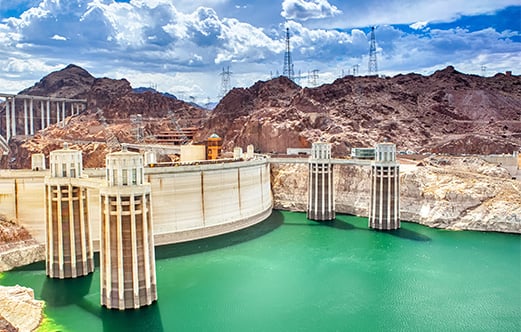Key Takeaways from Latest Industry Trends Meeting

NAIOP Research Foundation Governors, Visionaries and Distinguished Fellows met in Las Vegas during the CRE.Converge conference to discuss development challenges associated with water and power scarcity and possible research topics for future exploration. A panel, moderated by Marianna Hunnicutt, practice builder at Kimley-Horn and a NAIOP Research Foundation Visionary, discussed how the development community in Las Vegas is working with utilities and municipal leaders to meet sustainability objectives and ensure access to water and power for future projects.
Michael Bernardo, enterprise conservation division manager at Southern Nevada Water Authority (SNWA), provided an overview of how Southern Nevada is planning for future development while facing a limited supply of water from the Colorado River, which supplies 90% of the community’s water. Southern Nevada receives 1.8% of the river’s flow annually via Lake Mead, the nearby reservoir formed by the Hoover Dam, as part of an agreement with neighboring states. SNWA augments this supply by treating any water that enters an indoor drain and returning it to the river. Every gallon returned to the river is one that SNWA can pump back out from Lake Mead. Water conservation efforts are focused on limiting uses that do not return water to the sanitary sewer. Evaporative cooling in the form of cooling towers and swamp coolers currently represents the second largest use of water after landscaping, which uses 50-60% of the available water supply.
Steve Neiger, principal/managing broker, CAST, and Rod Martin, senior vice president, Majestic Realty, explained how NAIOP Southern Nevada worked with SNWA to come up with a workable plan to limit evaporative cooling. The water authority explained to the development community that if no limits were placed on evaporative cooling, all new construction would have to come to a halt within several years. The NAIOP chapter made it clear that a complete ban on all evaporative coolers would impose large costs on existing buildings and would force many to close if they could not be retrofitted with new roofs or expanded power capacity to support new HVAC systems. As a compromise, since the end of last year, evaporative cooling systems are now prohibited from being installed on new projects or added to existing buildings, but buildings with existing evaporative cooling systems can keep them.
As in many other markets around the U.S., Southern Nevada also faces challenges in delivering enough electrical power to meet a boom in demand. Eric Schwarzrock, vice president, customer solutions and projects at NV Energy, explained that the utility currently delivers nine gigawatts (GW) of electricity on peak demand days across the state of Nevada, but that the utility is under contract for another four GW of electricity for data centers that will come online in the next 10-15 years. Data center growth represents the largest driver of electricity demand, but electric vehicles are also increasing demand as EV charging stations are installed at homes, parks and other facilities. Complicating the utility’s efforts to meet growing demand, it has a goal to source 50% of its power from renewable energy by 2030. To that end, the utility is pursuing a multi-year project called Green Link, which will establish a triangle of 500-kilovolt transmission lines across the state of Nevada, opening up more of the state for future solar and battery plant installations. For data centers with large needs for consistent power and users that have their own sustainability objectives, geothermal may be a better option. The utility currently has a project underway to install 115 megawatts of geothermal generation for Google data centers.
In a group discussion, attendees suggested that the NAIOP Research Foundation consider researching a variety of topics in the future, including ways to fund infrastructure development from private and public sources; deregulation of electricity transmission and distribution; the impacts of a truck fleet electrification mandate in California; how different states approach permitting approvals for new electricity generation and transmission; what mix of sustainable power sources will ensure the reliability of the electrical grid; the potential of small package nuclear reactors; how developers and building owners can capitalize income generated by rooftop solar; and the effects of rent control regulations on commercial real estate development.

